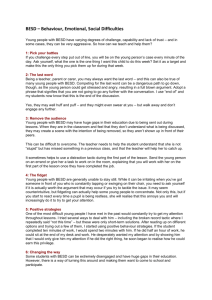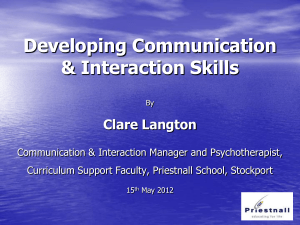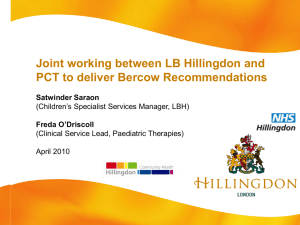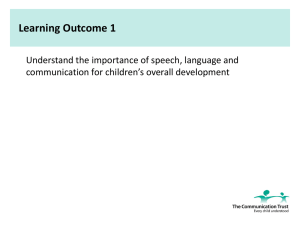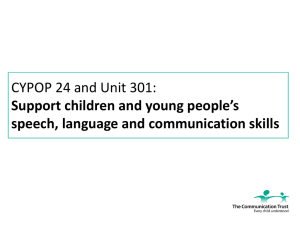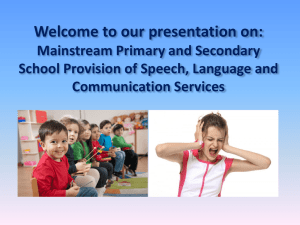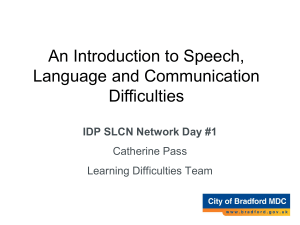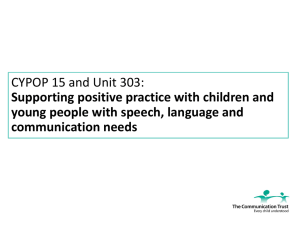What are behaviour, social and emotional difficulties?
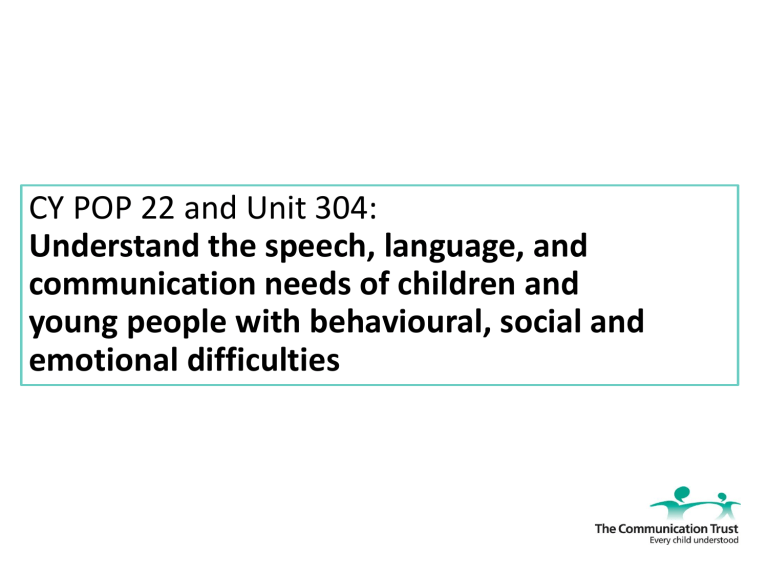
CY POP 22 and Unit 304:
Understand the speech, language, and communication needs of children and young people with behavioural, social and emotional difficulties
Learning Outcome 1
Understand the links between language, behaviour, emotional and social development difficulties
Speech, language and communication – a reminder
Language
Speech
Communication
Pre-session activity:
Ages and stages of language development
• Talk with a child or young person you work with. Try to observe them in two different situations. Note down examples of their speech, language and communication
• Using an ‘ages and stages’ resource, decide if their speech, language and communication skills are as you would expect
What are speech language and communication needs
(SLCN)?
• Most children follow the expected pattern of development for their speech, language and communication at the expected times. Some, however, do not. These are described as having speech, language and communication needs (SLCN)
What are behaviour, social and emotional difficulties?
Children and young people may be:
Withdrawn or isolated
Disruptive and disturbing
Hyperactive and lacking concentration
Irrational Over familiar Impulsive Self-harming
Unable to interact appropriately
Facing complex special needs
Anxious or frightened
They may have a diagnosis:
• Attention Deficit Hyperactivity Disorder
• Autistic Spectrum disorder
• Attachment Disorder
• Conduct disorder
• Depression
• Tourette syndrome
• Social/ school phobia
Associations between SLCN and BESD
Children and young people with SLCN
• May develop behaviour, emotional and social difficulties
• May be misidentified as having BESD
Children and young people with BESD
• Are more likely to have SLCN
• Are particularly likely to have social communication difficulties
• Often have undetected SLCN
• May have reduced opportunities
How SLCN may affect behavioural, emotional and social development in children and young people
You need language to;
• understand emotions and emotion words
• understand other people’s thoughts and feelings
• think things though and decide what to do
• help with self control
Children and young people with SLCN are at risk of developing BESD
Over fifty per cent of children who have SLCN develop behaviour, social and emotional difficulties and mental health difficulties of all kinds.
Activity 1a - Children and young people with SLCN are at risk of developing BESD
• Choose one of the examples of a difficulty with speech, language and communication. You could use other examples if you prefer.
• In groups, discuss what you think the impacts of this need might be on a child or young person’s behaviour, social and
emotional development.
Activity 1b How could difficulties with the social use of language impact on interactions?
How could difficulties with the social use of language impact on interactions?
After the activity discuss;
•
What are the implications for children with these sorts of communication difficulties?
•
Consider the effects on their social interactions, friendships and school work.
•
What might other children think of them and what effects could that have?
SLCN can appear to be BESD
For example:
• When a child or young person doesn't follow instructions
• If they don’t explain themselves well (it might seem like they’re choosing not to but perhaps they can’t)
• If they have poor social communication skills, (the listener maybe offended or confused)
Why is behaviour a form of communication?
We influence people and our environment through communication
– So what if we can’t use words to do that?
– What if the ways we communicate are not acceptable to others?
– What if we can’t understand what others are trying to say to us?
Children and young people with BESD are more likely to have SLCN
The number of children with BESD and communication problems seems to be ten times higher than in the general population
And their SLCN is often unrecognised
Incidence of SLCN in children with BESD
Activity 1c
How many have BESD+SLCN in your setting?
• How many CYP you work with have BESD?
• Given the incidence of SLCN in BESD, how many of them might have SLCN which has not been unidentified?
• What could you do to help identify them?
How behaviour difficulties can affect speech, language and communication development
Children and young people with BESD;
• Might either withdraw or be rejected so they have fewer opportunities to learn to interact.
• Often have limited attention skills, so all learning including learning language can be affected
• Often experience powerful feelings which can impair thinking and learning
CYP with BESD might be particularly likely to have difficulty with social communication skills
Change how they communicate based on situation and who they’re talking to
Know how to start a conversation and get attention in the right way Express ideas in a way that will make sense to someone else
Use and understand facial expression gesture and tone of voice
Child/ young person
Understand creative or unusual ways to use language
Activity 1d:
The effect of behaviour, social or emotional difficulties on speech, language and communication development
Work in pairs:
• You should each think of a child or young person you know and make a note of their behaviour, social and/or emotional difficulties, being as clear as you can.
• Swap your outlines with each other.
• Now consider how these difficulties might affect each child or young person’s speech, language and communication development.
Associations between BESD and SLCN
• The first sign of many mental health conditions is that language is slow to develop
• CYP with ADHD and Conduct Disorder often have social communication difficulties
• CYP with ADHD may need extra time to understand complex language
• In ASD; SLCN is part of the diagnosis
So SLCN+BESD can result in:
• Frustration- ‘I can’t get people to understand me!’
• Being misunderstood- ‘they think I won’t explain, but I can’t’ or ‘they want me to join in, but I don’t know how’.
• Not being able to explain how they feel-’I’m OK’
• Problems thinking about what to do, considering consequences and stopping just reacting e.g. ‘if I hit him it’ll hurt and I’ll get in trouble.’
• Not being able to join in and learn better communication and interaction skills
Activity 1e
• Look at the activity in the learner materials.
• Consider if any the statements relate to a child or young person you are working with.
• Can you think of any other reasons why children and young people with SLCN may develop difficulties with their behaviour, social or emotional development?
•
One thing I'll think differently about...
•
Something I'll tell someone else...
•
Something I'll do differently....
Learning outcome 2
Understand how to support positive speech, language and communication development for children and young people with behavioural, emotional and social difficulties
Activity 2a:
SLCN barriers to learning behavioural, social and emotional skills
From what you have already learnt
• Why might children and young people with SLCN find it difficult to learn behavioural, social and emotional skills?
• Consider barriers within
– Learning
– Making friends
– Interactions with adults
– Interactions with peers
Activity 2b:
Positive interactions?
What sort of interactions help children and young people learn communication, behavioural, emotional and interaction skills?
In a small group, look at the interactions listed in your learner handbook. Decide which of these are effective adult strategies to develop communication, behavioural, emotional and interaction skills?
Effective adult strategies to develop communication, behavioural, emotional and interaction skills
Positive and warm interactions; smiles humour and eye contact
Talking about emotions as they happen, e.g.” he looks upset look at his face”
Taking equal turns
Listen and follow CYP’s lead
Talking about what CYP are interested in
Comment on what the CYP is doing
Accept their ideas
Effective adult strategies to develop communication, behavioural, emotional and interaction skills 2
Modelling the language and behaviour you’d like to see
Specific praise for pro social behaviour, e.g. ‘great you gave him a turn’
Praise for effort, strategies or choices
Explaining why a behaviour is not OK and what you’d like them to be doing, e.g. “ no, that hurt him, say, ‘can I have a go”
Contingent consequences, immediate and relevant to the situation, e.g. “If you snatch you can’t have the toy”
Developing communication skills in children with BESD
Teach the language you’d rather they were using
Eg ‘can I have a turn?’ ‘this is really difficult for me’
Develop a broad emotion vocabulary
Eg: ‘I’m fed up – irritated – annoyed – livid’
Make sure they understand what’s likely to happen in situations they find tricky
Increase opportunities to practise communication skills
Reward good communication
Activity 2c
Developing communication skills in children with BESD- How could you put these into practice?
At play?
While managing behaviour?
How could you put these ideas into practice?
In class?
In conversation?
Helping children and young people learn how to interact with each other
• Promote on-task verbal interaction between CYP. Set co operative
goals and offer joint problem solving activities.
• Provide opportunities to work with individuals with good social
communication skills
• Make rules explicit; “its important to take turns, because.....”
• Notice and prompt e.g “does J want to make a point?”
Helping children and young people learn how to interact with each other
• Rephrase or restate if there is a problem, e.g. “I think x meant”
• Assign specific roles e.g. with LEGO; architect, finder and builder
• Positive peer reporting; work towards a whole group reward for noticing a peer’s positive behaviour
Activity 2d:
Communication friendly? True of false?
Lighting is irrelevant
Lots of chatter makes for a stimulating environment
Background music can help children focus
Encourage listening skills by avoiding visual support
Have visual displays which define and illustrate key vocabulary
Be explicit about routines and expectations
?
Activity 2d: possible answers
Lighting is irrelevant
Lots of chatter makes for a stimulating environment
Back ground music can help children focus
Listening skills develop when you avoid visual support
Have visual displays which define and illustrate key vocabulary
Be explicit about routines and expectations
Activity 2e:
What happens in your setting to support CYP with SLCN and
BESD?
Observe in context or on video:
• Adult strategies to develop communication, behavioural, emotional and interaction skills
• Opportunities CYP have to learn communication skills
• And how to interact with each other
• How the environment facilitates communication
• And the direct effects of these on CYP
Transfer into practice 2
Following your observation
• Which area would you like to develop?
• How could you do this
• In collaboration with......?
Learning Outcome 3
Understand how to adapt strategies and approaches to behavioural, emotional and social development to meet speech, language and communication needs
Effective approaches to BESD/mental health difficulties
Systemic
Considers child/young person in context of family, school, wider system of people who support them and how they all interact.
Behavioural
Assumes behaviour is learnt through reinforcement, so modifies behaviour through rewards and sanctions and identifying triggers.
Cognitive
Recognises how thoughts influence feelings and actions.
Reframes negative and unhelpful thoughts, there is a focus on the here and now
Therapeutic
Attachment theory, how past experiences can continue to affect us, the conscious and unconscious effect of emotions
Activity 3a
Effective approaches to BESD/mental health difficulties
Which are used in your setting?
Which do you find most useful?
Are they modified for CYP with BESD+SLCN?
Activity 3b - How are the needs of CYP with
BESD+SLCN reflected in....
• Behaviour policies: e.g. De-escalation; managing behavioural issues as they occur; Debriefing behavioural incidents
• Planning: e.g. opportunities to develop communication skills; incorporating speech and language therapy targets into planning; adult interaction strategies
• Observations e.g. developing adult skills in interaction
Can adult communication contribute to BESD?
Think of a young person or observe;
When the language is complex
Do they complete the work successfully ?
How do they behave?
How well do they listen?
If you simplify the language does anything change?
Teach clarification skills....
If someone We could say…
• Speaks too fast
• Speaks too quietly
• Doesn’t give us enough time
Can you say that a bit slower?
Could you say it louder please?
Can you say that again please?
• Uses complicated grammar What does that mean?
• Doesn't give enough information Which pen do I use?
• Gives an instruction that's too long
• Uses unfamiliar words
I can't remember all that
What does that word
'precipitate' mean?
Activity 3c:
Managing behaviour
Think of a recent situation where a CYP was not behaving as you would expect
What did you do or say....
Activity 3c:
If the CYP had SLCN these might have helped
•
Listening and giving them plenty of time to think about what you said.
•
Using vocabulary and sentences which they can understand.
•
Providing visual support to help them understand the sequence of events or actions and consequences.
•
Giving opportunities to ask for clarification for example teaching questions such as “I don’t know what ‘consequence ’ means”
•
Explaining what you wanted them to do or say
•
Demonstrating open questions
Transfer to practice: 3
•
Are there any areas of practice, systems or policy you’d like to amend to reflect the needs of CYP with SEBD+SLCN?
– Planning?
– Observation?
– Behaviour policy ?
» Teaching the skills to behave well
» Managing behaviour as it occurs?
» Debriefing behavioural incidents ?
•
What is the first step towards this?
Learning Outcome 4
Know how to work with others in order to support the speech, language and communication development of children and young people with behavioural, emotional and social development needs
Activity 4a
List the stresses there might be on a family with a CYP who has
BESD+SLCN
Stress related to
BESD?
Other stresses
Family
Stress related to
SLCN
Other stresses
Working in collaboration with families
•
Listen carefully
•
Liaise with families, involve them as equal partners
•
Use appropriate forms of communication, verbal and non verbal, in managing relationships, conflict and negotiation
•
Respect their situation, be non judgemental
• Inform families of progress and any potential problems
•
NB Consider the range of family structures and backgrounds in your setting and the importance of respecting and valuing diversity
•
NB Remember how family beliefs, attitudes and values may affect behaviour, self-reliance and identity
Activity 4b
Who does what?
Aims to reduce psychological distress and to enhance and promote psychological wellbeing.
Develops evidencebased SLCN intervention plans
Assesses using a variety of methods including psychometric tests, interviews and direct observation
Supports children who lack confidence or self-esteem as well as having poor social and/or behaviour skills
Assesses speech language and communication skills
Works with groups of children with
BESD
Activity 4b
Who does what – possible answers
Speech and
Language Therapist
Assesses speech language and communication skills
Clinical Psychologist Behaviour Support
Worker
Assesses using a variety of methods including psychometric tests, interviews and direct observation
Supports children who lack confidence or selfesteem as well as having poor social and/or behaviour skills
Develops evidencebased SLCN intervention plans
Aims to reduce psychological distress and to enhance and promote psychological well-being.
Works with groups of children with BESD
Many others could also be involved...
People
• Learning mentors
• Teaching assistants
• Home-school worker
• Behaviour support teacher
• Education welfare officer
• Social workers
• Educational Psychologists
Services
• Behaviour and Education
Support teams
• Youth offending teams
• Child and adolescent mental health teams
• Police services
• Youth services
• Voluntary agencies
Activity 4c
Increasing collaboration ?
What opportunities are there to learn from other professionals and share your own expertise?
– Observation
– Demonstration
– Joint supervision
– Discussion about roles and expectations
– Joint problem analysis, action planning and implementation
– Time to reflect?
How might this benefit CYP and their families ?
Transfer to practise: 4
Who would you like to understand better?
Who would you like to meet with to find out more about their role/situation?
How could you set up meetings with a professional or a family and perhaps spend some time with them?
Hello
2011 is the National Year of Communication
‘Hello’ is a national campaign run by The Communication Trust, complementing the Government’s commitment to support children with speech, language and communication needs.
Please visit www.hello.org.uk for more information on how you and your setting can help improve the communication skills of children and young people – so that they can live their life to the full.
